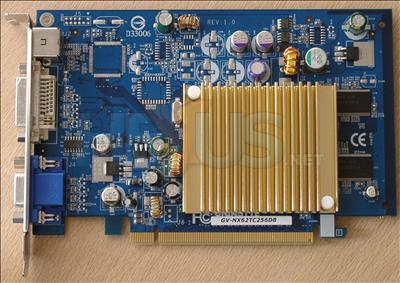System setup and notes, issues
System setup
To test the capabilities of MSI's card we ran the usual gamut of HEXUS 3D benchmarks, comparing it against a similar card from ATI and a few integrated and previous generation SKUs. Below are our system setups for the tests.
| NVIDIA GPU test system | ATI GPU test system | ||||
|---|---|---|---|---|---|
| CPU | AMD Athlon 64 Socket 939 (2.2GHz, 512KiB L2 cache, single-core) | ||||
| Motherboard | Asus A8N-VM CSM (Nforce 430 with GeForce 6150) | ECS RS482-M, (ATI RS482+SB400) | |||
| BIOS | 0702 (01/17/2006) | 1.2b (03/14/2006) | |||
| Chipset software | Nforce driver pack 8.22 | Catalyst 6.2 Southbridge driver package | |||
| Memory | 512MB (2 x 256MB) Corsair VS512MBKIT400 PC3200 | ||||
| Memory timings | 2.5-3-3-8 1T @ 400.18MHz | ||||
| Hard drive | 160GB Seagate Barracuda 7200.9 (3Gb/s mode) | ||||
| Operating System | Windows XP Pro SP2 | ||||
| Monitor | AG Neovo E-17A 17in TFT | ||||
| Graphics card | NVIDIA GeForce 6150 128MB (475/400MHz) | Gigabyte GV-NX62TC256D8 6200 TurboCache 256MB (350/500MHz) | MSI NX7300GS-TD256E 7300GS 256MB (550/810MHz) | ATI Radeon Xpress 200 256MB HyperMemory (301/500MHz) | ATI Radeon X1300 PRO 256MB DDR2 PCIe 16x (594/792MHz) |
| Graphics BIOS | 5.51.22.26.07 | 5.44.02.32 | 5.72.22.34 | 008.046I.000.00 | 009.012.006.002 |
| Graphics driver | 84.21 | 8.243-060404a-033273E-ATI | |||
Gigabyte kindly provided a budget card from the GeForce 6 range for us to test the 7300 GS against. The GV-NX62TC256D8 is a GeForce 6200 Turbo Cache and is pictured below.
It's visibly much larger than the 7300 GS from MSI, but does have a completely passive cooling solution in its favour.
Testing software
- Far Cry 1.33
- Quake 4 1.04
- Splinter Cell: Chaos Theory 1.05
We tested at resolutions of 1024x768 and 1280x1024; higher would have been unfair on these SKUs to say the least.
We lowered in-game settings in Quake 4 and SC:CT with the integrated GPUs to improve framerates (as a user would), but this means the results are not directly comparable with the other cards in the strictest sense. In Quake 4 we disabled bump maps along with shadows and specular lighting, and in SC:CT we disabled trilinear filtering, specular lighting, high quality textures and hardware shadow mapping, setting shadow resolution to low too. The Radeon Xpress 200 graphics had to be run on shader model 2.0 in Far Cry and SC:CT, whereas all other SKUs were run using 3.0. Finally, only the 7300 TX and X1300 Pro add-in-boards worked with HDR in all its glory, so for testing of that we've provided HDR and non-HDR results, omitting the SKUs that couldn't deal with HDR for those particular test runs.
Issues
During testing for this review we encountered crashing during the HEXUS Far Cry time-demo in conjunction with the ECS RS482-M board. During the test, the system would hang at seemingly random points. This would only occur when using integrated graphics, not an add-in-board. After exhausting all avenues of troubleshooting we tried to source an alternative motherboard. Sapphire kindly provided us with the PE-A9RS482M.
Sadly, we encountered the same problem with the Sapphire board. In communication with ATI we eventually received an engineering release driver which fixed the problem. It is that driver which we used for testing, as shown in the system setup table. The Catalyst 6.6 release onwards should contain the fix, though we have not been in a position to test this ourselves.
The MSI NX7300GS-TD256E escapes from the issues unscathed.










